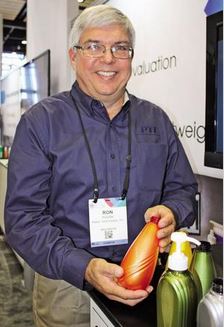Bubbles add some flair to 'Plain Jane' PET bottles

CHICAGO — Ron Puvak and the folks over at Plastic Technologies Inc. see big things coming from some very tiny bubbles.
The Holland, Ohio-based company is touting a technology called Fi-Cell that dramatically alters the appearance of PET bottles in a way the company believes opens up new markets for the packaging stalwart.
As director of marketing and new business development at PTI, it’s part of Puvak’s job to explain the benefits of Fi-Cell to the market. For him, it’s an easy sell.
He believes foamed PET bottles are a game-changer. And those are not words his PTI crew likes to throw around casually, he said.
“Today, the brand owner has what, 2.3 seconds to catch a consumer’s eye on a shelf? Now with this technology, they can generate a package that isn’t Plain Jane anymore, that has snap and appeal long after it leaves the store shelf,” he said at Pack Expo in Chicago recently.
Fi-Cell creates monolayer containers with a “visually-exciting metallic finish without the use of expensive metallic colorants,” according to PTI.
Fi-Cell technology, which creates tiny bubbles within PET, was actually created by Toyo Seikan Co. Ltd., who was looking for a partner to help expand its adoption. It joins PTI’s own oPTI foam bottle technology that was introduced years ago.
Now PTI has two foam bottle arrows in its quiver to offer clients looking to differentiate their offerings.
Foamed PET introduces liquid nitrogen during the creation of preforms, which then become opaque when the bottles are blow molded.
“The cost of any foam bottle platform, no matter which one we talk about, is all in the capital side. You have to modify the injection molding system to be able to foam the package. After that, it’s like any other blow molded package,” he said. There’s no impact on the filling side as well.
Puvak declined to talk about the cost of making changes on the injection molding side for Fi-Cell, indicating those costs are dependent on each particular application.
A side benefit to foaming PET is that the material becomes more receptive to embossing than the regular stuff.
“PET has this wonderful characteristic of self-leveling. It never wants to be sharp. It wants to level itself. But with oPTI or Fi-Cell, we found we actually get some nice embossing effects,” Puvak said.
“You’ve got these little bubbles that love to move a little bit, so that’s what’s happening. You get this very nice embossing effect. You will not see that in a standard PET bottle,” he said.
This provides companies with the opportunity to feature their brand equity in their PET packaging, Puvak said.
Foamed PET also allows for the use of less colorant as the tiny bubbles do not need to be colored. “We color the PET and the foam comes along for the ride,” he said. Foamed PET without colorant creates white or silvery opaque bottles.
Foamed bottles also can weigh up to 5 percent less than their more pedestrian cousins, but Puvak said this technology really isn’t about lightweighting.
“We don’t see lightweighting as the big key here. Really what we see is the shelf differentiation and use of PET in another way,” Puvak said. “All we’ve done is given PET another pathway to take.”
PTI sees carbonated beverages, wine, spirits and cosmetics among the potential markets for foamed PET. “All of these things that are looking for shelf differentiation,” he said. “We’re seeing interest across the board.”
